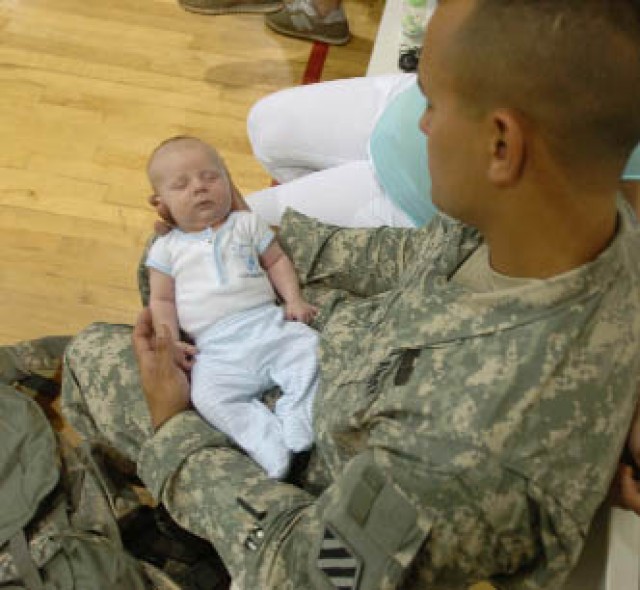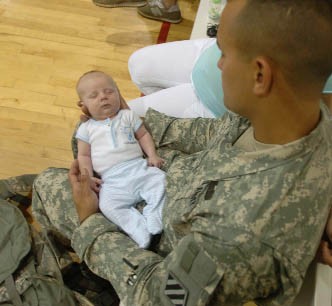FORT MCPHERSON, Ga. -- You won't find it spelled that way in the dictionary, and spell check will mark it with a squiggly red underline, but for thousands of Soldiers and their Families, relief is spelled AER.
The Army Emergency Relief fund is a 67-year-old Army program incorporated by Secretary of War Henry Lewis Stimson and Army Chief of Staff General of the Army George Marshall.
The goal of the nonprofit organization is to provide emergency financial assistance to Soldiers and their Families.
The program does so by providing interest-free loans or grants, said Jolane Williams, AER officer at Army Community Service, part of the U.S. Army Garrison Directorate of Morale, Welfare and Recreation.
"There's no minimum or maximum if it is a true need or emergency," Williams said of the given amounts. "AER does its best to fulfill Soldier and Family needs."
Needs can take a variety of forms, including pay issues, money to pay rent or a mortgage, utilities, funeral expenses or to purchase food, she added. AER also helps Families maintain or repair their personally owned vehicles, one of the most common uses around Fort McPherson and Fort Gillem, Williams said.
"We don't want Soldiers and their Families to have to live without the necessities," she said.
A Matter of Death and Life
The moment of need for Spc. John Ring Reinke, a mechanic with the 3rd Military Police Group of the Fort Gillem Criminal Investigation Division, came throughout the last year, beginning with the death of his father-in-law in a boating accident.
"The day after Father's Day I got a Red Cross message," he said. "My father-in-law drowned in the Colorado River while kayaking."
Taking care of the funeral would require Reinke and his spouse, Ashley, to travel to Colorado, an extremely expensive trip he said, especially with the price of gas still around $4 a gallon at the time.
"AER covered our gas, hotel, travel and the cremation," Reinke said. In addition to his $2,500 loan, his spouse's brother, Spc. Josh Banks, serving with 3rd Army in Kuwait, also received an AER loan and was flown back to help. "AER was definitely helpful during this difficult time," Reinke said.
It was a helping hand Reinke would return to a few months later, in October, during the birth of his daughters. Ashley discovered she was pregnant during the trip to Colorado to bury her father. It was a pregnancy full of unexpected twists, difficulties and worries, Reinke said, the first twist coming when they discovered Ashley was carrying twins.
While creating the two lives within her, complications arose that almost ended Ashley's life, Reinke said.
"My wife's nervous system was shutting down. She was dying," he said, adding doctors diagnosed preeclampsia.
Preeclampsia arises in pregnancy when the placenta is shallowly implanted, causing a lack of oxygen to the placenta and leading to a variety of complications that can be both fatal to the mother and the fetus, according to the Mayo Clinic, a non-profit medical practice dedicated to the diagnosis and treatment of virtually every type of complex illness.
With no cure other than abortion or induced labor, the couple went to Henry County Medical Center in Stockbridge to have the twins delivered.
Savannah and Kyleigh were delivered Oct. 18 via Caesarean section, several months earlier than their expected due date of Feb. 6, Reinke said.
Severely premature, the two were placed in the hospital's neonatal intensive care unit. Savannah weighed 15 ounces at birth and measured 10.5 inches, while Kyleigh weighed 1 pound, 4 ounces and measured 11 inches, Reinke said.
The average baby weighs 5 to 9 pounds and measures 19 to 22 inches, according to the National Center for Health Statistics.
Despite the doctor's best efforts, Savannah died in the neonatal intensive care unit. The prognosis for Kyleigh was equally grim.
"The doctors said she wasn't going to make it," Reinke said, due to problems with the blood vessels in her heart, which were understrength due to the premature delivery. "They sent her to Eggleston Childrens Hospital in Atlanta (for surgery)."
To cover the expenses of traveling to and from Eggleston, Reinke again turned to AER for assistance.
"We didn't have the credit at the time. AER helped us relieve the stress," he said. To cover the expenses, the Reinkes received nearly $1,000 in grants.
The money helped Reinke and Ashley visit their daughter through the ordeal, which lasted until March 12, when she was released home.
"It's definitely interesting being a father," Reinke said. Although Kyleigh is 5 months old, she is essentially developed only as far as a newborn and may take longer to develop compared to a normal child, but otherwise is doing fine, he said, adding she weighs 9 pounds now.
"We went through so much with her. I'm really thankful for AER helping me take care of things," Reinke said. "I'm definitely thankful to be in the Army."
Ordinary or extraordinary, AER doesn't discriminate
While Reinke's situation isn't normal, what is normal is AER's willingness to help Soldiers and their Families in need, Williams said.
According to the AER Web site, since its inception, AER has helped more than 3 million Soldiers and Family members with more than $1 billion. For every dollar donated, 89 cents goes to helping Soldiers.
On Fort McPherson and Fort Gillem, help in the past year totalled almost $1 million, Williams said.
"Last year we collected $47,555.06 and had almost 20 times the return investment," she said. "We helped 693 Soldiers and their Families for $945,490.17."
Much of the success of the program goes to Williams, said Capt. Michelle Lewis, Headquarters and Headquarters commander, 52nd Explosive Ordnance Disposal Group.
"Mrs. Williams is very accessible. She and the AER staff work hard to make funds immediately available. I've been to several posts, and the AER program here is really awesome," Lewis said.
Lewis is involved in the AER program, often using the commander referral option, an option that allows unit commanders and first sergeants to give their Soldiers an AER loan up to $1,000, Williams said. Because commanders have more interaction with their Soldiers than the ACS office staff, the commander referral option helps get funds to Soldiers in need quickly.
"When I see one of my Soldiers has a need, as long as it is emergency, an immediate need, it [AER] is always an option," said Lewis, adding that a first line of resort is to go through the Soldier's budget to see if the emergency can be managed that way first.
However, sometimes things happen so quickly or unexpectedly that there is no choice but to go to AER.
"I was always a donator," said Master Sgt. Jessie Brackin, operations NCO for G3 in First U.S. Army. "I just never thought I would have to use it."
Brackin, an Army Reserve Soldier who owns and operates a peanut, cotton and corn farm, lost his son, Milus Brackin, 17, and brother, Hank Brackin, when an acetylene tank in one of his barns exploded March 26, 2007. Hank, 32, was killed instantly while Milus sustained third degree burns over 95 percent of his body, Brackin said.
For 30 days Milus hung on in an Augusta hospital before succumbing to his injuries, a time that saw Brackin and his wife, Tessie, there to support him, something that couldn't be possible without an immediate grant for $1,500 for travel and daily needs and the $10,000 AER loan he received.
"We were struggling. We didn't have the money," Brackin said. "Having the Army's help, my chain of command and AER made me proud to be in the Army. It gave me even more respect for the Army."
Brackin, who has served 29 years, said the grant and loan from AER did more than allow him to be with his son during his last days and to bury Milus and Hank. By providing him with this need, extra stress from wondering where to get the money was eliminated - stress that could have been extremely damaging to his relationship with Tessie during the time of struggle.
"With all the stress going on, I don't know if our marriage would have made it (without the additional relief). I don't know if we would have gotten separated," he said. "It's a very good program."
And one that anyone can contribute to help make it successful.
AER is in the middle of its annual fundraising drive, which takes place between March 1 and May 15, Williams said, although donations are accepted year-round for the program.
"This is an opportunity to help Soldiers," Lewis said. "Everyone faces hard times; this is one way to relieve their problems without taxing the Soldier."
"It really helped me and my family out," Reinke said. "That's why I give."
AER is open to all active duty Soldiers and their Family members, military retirees, surviving spouses, orphans of Soldiers who died on active duty or after they retired and Reserve and National Guard Soldiers activated for more than 30 days under title 10, federal service, Williams said.
"You never know when you'll have an accident or a problem," Brackin said. "But with AER, support is always there."


Social Sharing